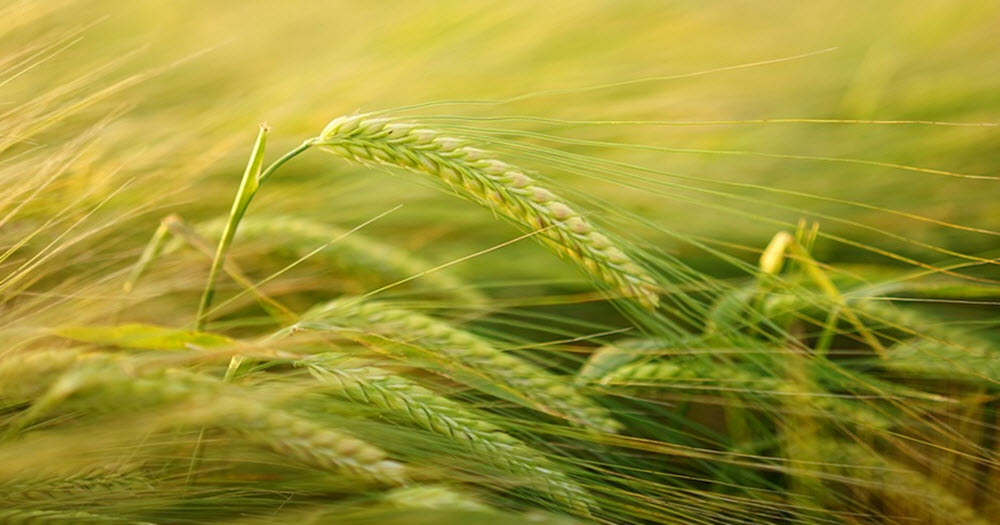Contents
Barley is one of the major cereal grains, and it has been cultivated in Eurasia for at least 10,000 years. Barley is used as food for both humans and animals and is also a key ingredient in beverages such as whiskey and certain beers.

Barley farming
Barley is an adaptable crop that can be grown in both temperate and tropical parts of the world. It has a fairly short growing season. Compared to wheat, barley is more tolerant of salt in the soil.
Data from 2017 show that in that year, nearly 150 million tonnes of barley was produced globally. This placed barley on spot #4 in terms of cereal production, outranked by maize (corn), rice and wheat. Russia was the main producer, with 14% of the world´s barley production hailing from Russian fields.
The germination time for barley is 1-3 days.
Barley is self-pollinating.
Both two-row and six-row barley is farmed
Domesticated barley is either two-row or six-row.
In wild barley, only the central spikelet is fertile, and other two spikelets are reduced, a configuration that produces two-row barley. This configuration is retained in some of the domesticated barley (two-row barley), but there is also another version available: six-row barley. In six-row barley, there are three fertile lateral spikelets.
Two-row barley has lower protein and higher sugar content than six-row barley. It is the common choice for traditional English-style and German-style beers.
Six-row barley is chiefly farmed to produce animal feed, but amylase-rich six-row barley is also used to create certain lager-style beers in the United States.
About barley
Kingdom: Plantae
Order: Poales
Family: Poaceae
Subfamily: Pooideae
Genus: Hordeum
Species: Hordeum vulgare
Barley is a member of the grass family. Our domesticated barleys developed from the wild Hordeum vulgare subsp. spontaneum, which is still commonly seen growing in Western Asia and Northeastern Africa. In some sources, it is considered a separate species and named Hordeum spontaneum.
The domesticated barley is fairly different from wild barley, as its morphology has changed to be better suited for farming. Wild barley grain is elongated, while domesticated barley has more of a rounded sphere. Wild barley produces a brittle spike, and when the seeds are mature the spikelets will separate to promote seed dispersal. Domesticated barley has non-shattering spikes, which makes it easier to harvest mature barley. Domesticated barley does not need shattering spikes, since it will be dispersed by humans.
Main barley producers in 2018
(Data source: FAOSTAT of the United Nations Food and Agriculture Organization, Statistics Division, 2018)
Russia: 16.99 million tonnes
France: 11.19 million tonnes
Germany: 9.58 million tonnes
Australia: 9.25 million tonnes
Spain: 9.12 million tonnes
Canada: 8.37 million tonnes
Ukraine: 7.34 million tonnes
Turkey: 7.00 million tonnes
United Kingdom: 6.51 million tonnes
Argentina: 5.06 million tonnes

Barley cultivars
There are many different cultivars of domesticated barley, with various characteristics. Here are just a few examples:
- Azure. This is a six-row malting barley introduced in the 1980s. It is known to be high-yielding and has a strong straw, but is not resilient to the fungus loose smut.
- Beacon. Unlike Azure, this six-row malting barley cultivar is not very susceptible to lose smut infestations. It was developed by the North Dakota State University in the United States. It has rough awns and short rachilla hairs.
- Diamant. A high-yield, short-height Czech cultivar developed using X-rays.
- Maris Otter. This is a two-row English cultivar now commonly used to make malt for traditional-style English beers. Many craft beer producers use Maris Otter. The cultivars Proctor and Pioneer are both parent cultivars of Maris Otter.
- Pinnacle. This is a fairly new cultivar, released by the North Dakota Agricultural Experiment Stations in 2006. It is medium tall, strong-strawed, high-yield and low protein.
- Golden Promise. This is an English demi-dwarf barley cultivar famous for being especially salt-tolerant. It was developed using gamma rays. Golden Promise is used for both whiskey and beer production.
- Betzes is an old German two-row barley cultivar that matures during mid-season. It is mid-short, the straws are of medium strength and the kernels are midsize to large. It is not very resilient to lose smut, covered smut, scald and rusts.
- Centennial. This two-row cultivar was developed by the University of Alberta, Canada to be suitable as feed barley. It is a cross between Lenta and Sanalta. It is fairly short, stiff-strawed and matures later in the season.

